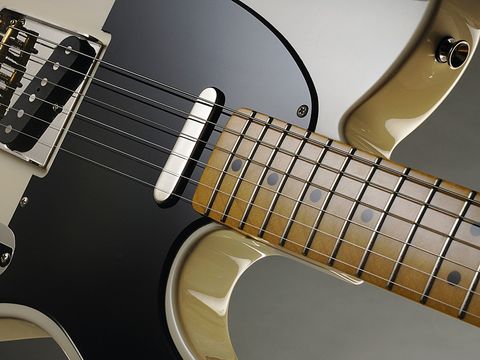The first Squier JV - or Japanese Vintage - guitars hit the streets in 1982 and the Strats in particular proved popular immediately thanks to excellent quality and American pickups. Fast-forward to 2008 and here is latest range of Far Eastern (Chinese in this case) Squiers: the Classic Vibe series.
On first glance you might assume that Squier's Classic Vibe guitars are intended to be the first foray into a selection of Squier-branded vintage reissues, but the idea is rather focused more on the intention to hark back to those halcyon early eighties days of the JV and recapture that vibe.
Classic Vibe Telecaster '50s
The Tele's pine body is certainly a more than decent aesthetic substitute for ash as, beneath the off-white Vintage Blonde finish, there's just enough of that characteristic streaky grain on show.
One assumes that the appearance isn't quite so convincing under the arguably more authentic butterscotch finish but, once again, it is vibe rather that unbending accuracy that's the goal here.
"No-one's pretending that pine is as desirable a tonewood as the more traditional ash but the Classic Vibe acts exactly how any Tele should."
Pickups comprise a standard Alnico III Telecaster set selected by a barrel-tipped three-way lever switch, and the nickel-plated hardware is laid out in the standard formation.
The vintage bridge includes three brass barrel saddles to facilitate thru-body stringing. Although in no way as stout as those fitted to a US '52 Reissue, they do their job admirably and, should you desire, are easily changed out for replacements.
Sounds
Hear the Classic Vibe Tele in action in the following clips, starting with the bridge pickup and moving through the middle and neck settings:
Alnico IIIs tend to drive at lower gains, and they give the '50s Tele a full tone that also benefits from a slightly improved level of warmth. In other words, it gives a markedly more vintage-sounding performance.
The Telecaster provides no surprises and sounds exactly as you'd expect: plenty of clean zest, high-end brang and higher gain body.
No-one's pretending that pine is as desirable a tonewood as the more traditional ash but the Classic Vibe acts exactly how any Tele should reasonably be expected to, certainly at this price, with no hint of fuss or struggle. It also stands up to all manner of double-stop and behind the nut bending techniques - just as it should.
Although Squier's Standard Series (from £209) represents good value, we must now suggest that the Classic Vibe range has become the initial port of call if you're after your first Telecaster.
The guitar is ripe for upgrading and its construction is more than robust enough to allow for both hardware and pickup upgrades.
The truth is, however, that even accomplished players may not need to carry out such tasks - the overall quality of the existing fittings is well up to par. There really is no excuse whatsoever for not owning a Fender-style electric with added mojo and vibe.

